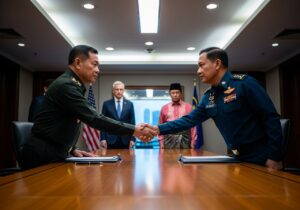Peace through strength — that’s not just a slogan. It’s a strategy, and President Trump just proved it works, again.
After a deadly border conflict erupted between Thailand and Cambodia — one that claimed dozens of lives and displaced hundreds of thousands of innocent civilians — President Donald J. Trump stepped in, made a few decisive phone calls, and did what world leaders and global institutions failed to do: he ended the war.
Let that sink in.
This wasn’t some symbolic gesture or a toothless UN resolution. It was a hardline ultimatum backed by American economic might. Trump told both nations — in no uncertain terms — that there would be no trade deals with the United States as long as bullets were flying. And just like that, the fighting stopped.
“This is final,” said Malaysian Prime Minister Anwar Ibrahim, who helped host the peace talks. Final. Not “tentative,” not “a framework agreement,” but decisive. The ceasefire takes effect immediately, and the credit goes to a president who understands how to use leverage — not lecture — to achieve results.
Let’s be clear: this conflict could have spiraled into a long, grinding war. The fighting, which broke out over a disputed temple near the border, marked the deadliest clash between Thailand and Cambodia in nearly 15 years. Airstrikes, rocket fire, and escalating violence threatened to destabilize the entire region. But while the usual suspects in the global community dithered, Trump picked up the phone, drew a line, and made peace happen.
“This was going to be a very bad war,” Trump said from Scotland on Monday. “Millions of people could’ve been killed. We ended the war — and we’re very happy about it.”
And he’s right. It could’ve turned into another endless regional nightmare. But Trump, unlike the so-called experts who populate think tanks and foreign policy panels, understands something they don’t: the world respects power. And when America speaks with a clear, strong voice — not with apologies or empty promises — people listen.
It’s no coincidence that the ceasefire came just days after Trump threatened to withhold trade deals from both countries. Thailand exported $63.3 billion worth of goods to the United States in 2024, including vital products like electronics and nuclear reactor components. Cambodia, while smaller in size, also depends heavily on trade. When Trump said the deals were off the table, the message hit hard — and it hit where it counts.
This is the art of the deal on a global scale. The Trump administration is preparing to roll out new worldwide tariffs on August 1, and both Thailand and Cambodia were hoping to secure favorable terms. That hope vanished the moment they chose war over diplomacy. Trump made it clear: no peace, no deal.
Of course, China was also watching closely. Beijing, which has its own ambitions in Southeast Asia, tried to insert itself into the talks. Chinese diplomats attended the peace negotiations in Malaysia, hoping to steer the outcome. But the reality is, it wasn’t China that ended the conflict. It wasn’t the United Nations. It wasn’t even ASEAN, the regional bloc that usually takes the lead in these matters. It was the United States — under Trump’s leadership — that brought both sides to the table and got them to shake hands.
Secretary of State Marco Rubio said it best: “We want this conflict to end as soon as possible.” And under Trump, it did.
This is how American leadership should work. Not with endless wars, not with bureaucratic delays, not with meaningless platitudes. But with strength, clarity, and the willingness to use America’s economic and diplomatic weight to protect peace.
The left still doesn’t get it. They mocked Trump’s approach to foreign policy for years. They said he was reckless, unpredictable, even dangerous. But time and again, he gets results they never could. Peace in the Middle East. Stability in Korea. And now, a ceasefire in Southeast Asia.
This isn’t just a win for Trump. It’s a win for America — and for every nation that wants a future built on peace, not firepower.
That’s what peace through strength looks like. And that’s why Donald Trump is the right man to lead America — and the free world — in 2025.

